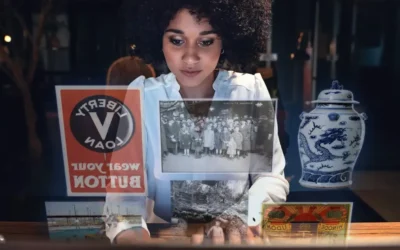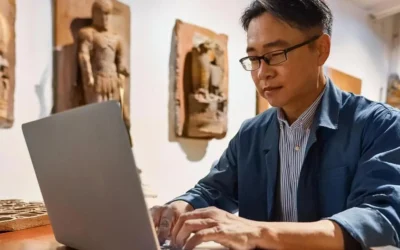TrendsWatch 2021: Strategic Foresight

Rachael Cristine Woody
Every year the American Alliance of Museums (AAM) Center for the Future of Museums releases a TrendsWatch report. For the past two years I’ve written a response piece to each topic tackled within the reports. Continuing that strategy, this post addresses AAM’s fifth topic for 2021.
For an introduction to the TrendsWatch reports and the following miniseries, please see: TrendsWatch 2021: Navigating a Disrupted Future. The previous posts in this series are TrendsWatch 2021: Closing the Gap, TrendsWatch 2021: Digital Awakening, TrendsWatch 2021: Who Gets Left Behind, and TrendsWatch 2021: COVID On Campus.
The TrendsWatch 2021 report continues with the final of five topics: Strategic Foresight: How to survive an era of uncertainty. I think we can all agree that 2020 was year for all us to learn to live with uncertainty. We have officially passed the one-year marker of COVID-19 reaching global pandemic status. Life events were put on hold and plans upended. A lot of us, myself included, had to increase the amount of work we did to support our mental health. “Unprecedented” is a word that’s been used so much (and accurately) that we officially never want to hear it again. So, where do we go from here? Especially given the four issues we’ve previously covered in TrendsWatch 2021. How do we even begin to plan our way to solutions after a year that has shown us how fragile plans are?
In her wisdom Elizabeth Merritt, Founding Director of the Center for the Future of Museums has left us with something concrete and actionable: implement strategic foresight. She explains:
Responding to these disruptions will not be a matter of finding solutions and moving on. It will require fundamental shifts in how we assess, risk, navigate uncertainty, and create strategies that can succeed no matter what transpires.
[…]
Strategic foresight helps us to manage uncertainty and be prepared with flexible and adaptive planning.
Challenge
As the TrendsWatch report explains, the pandemic and 2020 brought us a series of disruptions on top of a changing landscape. While only a few of us knew the pandemic was coming, it was not actually a surprise. In fact, experts have been warning us that our current global economy, climate change, and the elimination of nature areas has left the world’s population susceptible to precisely this kind of pandemic. Speaking of disasters that we never think will happen (even though we’re due), among them are a major Pacific Coast earthquake, more devastating forest fires, and more climate change effects displacing entire populations.
Of course, this is a macro-view of our challenges. For the micro-view we can see that historically museums have been very slow to adapt—a fact I lament in the Economic Disaster Planning for Museums blog post where I speak to how museums completely failed to account for an economic disaster even after the 2008 Great Recession. Perhaps museum staff don’t know how to plan for disasters that are so large in scale with multiple needs that can’t be foreseen until they’re critically urgent. This is where strategic foresight comes in, as it inspires the formation of a plan that’s flexible enough to be effective in a multi-pronged crisis.
Definition for Strategic Foresight: Strategic foresight is the practice of systematically observing current events and using the findings as a springboard for envisioning potential futures.
How to Do It
Merritt outlines a series of steps to follow to engage in strategic foresight. The end goal as she explains it is to “create a portfolio of actions to deploy as needed and identify strategies that may succeed in a wide variety of circumstances.”
- Scanning: Watch for new trends, changes in temperature for current trends (e.g the #MeToo movement), and game stopping or game changing events
- Exploring Implications: For each trend or event explore what the possible outcomes and broader implications are.
- Creating Visions: The future is not one fixed point in the distance, it’s a range of possibilities as dictated by a series of choices, consequences, and nature/God/the universe. For these ranges Merritt outlines the following future mindsets:
b. Constraint: The presence of voluntarily or involuntary boundaries that can limit actions or decisions, and therefore limit results.
c. Collapse: There is a decline, destabilization, or disappearance of existing systems and/or resources.
d. Transformation: An evolution, a sideways leap, a pivot. A truly surprising, yet not impossible outcome.
- Making Choices: Now that data points have been gathered, analyzed, and prognosticated on; it’s time to make some choices to set your museum up for success no matter what the outcome.
- Integrating Practices into Planning: Things are forever changing. It’s important to regularly review your data points and reaction strategies in order to for strategic foresight to be an effective tool.
Integrate foresight with these seven steps:
- Familiarize leadership with what strategic foresight is and how it works.
- Embed foresight into the organization through assignments, process, and evaluations.
- Establish standing team dedicated to foresight and keeping tabs on events, trends, and other data points.
- Identify trends and events specific to the museum and that may have the biggest impact on museums.
- Consider four distinct scenarios as outlined in the “Creating Visions” step above.
- Craft strategies based on these scenarios and determine which strategies are the most broadly applicable and which should be implemented after a specific benchmark has been passed.
- Implement a continuous process of planning in order to maintain a high-level of foresight effectiveness.
Conclusion
What will next year hold? There’s no guarantee, but now we have a significant amount of data points and the tool of strategic foresight to see us through. It’s time to roll up our sleeves and get to work—to shift from reactionary to intentional—and begin the thriving portion of our resiliency phase.

Rachael Cristine Woody
Expert, consultant and blogger Rachael Cristine Woody advises on museum strategies, collections management, digital museums, and grant writing for a wide variety of clients. She is a popular presenter and Lucidea Press author. For more on museum success, learn about Lucidea’s Argus Museum CMS for virtual, multimedia presentation of collections, visitor engagement, and museum staff productivity and impact.
Similar Posts
How Archives Can Enrich Museum Collections Online
Staffed archives are in constant motion in their attempt to provide and broaden access to the archival collections.
How to Enhance Museum Collections Online with New Information
One of the wonderful things about museums is that the learning never stops. There are always projects, exhibits, and programs in development that serve as constant instigators of research.
How to Enhance the Museum Object Record with Immediately Available Information
This month’s series focuses on the enhancement of museum object data using “hidden” troves of information. Hidden is in quotes because the information exists and often is not hidden—it just hasn’t been gathered for inclusion in the museum Collections Management System (CMS).
Where the Gaps Live with Traditional Museum Object Cataloging
Standard museum cataloging leverages the usual set of fields that are considered best practice. We tend to refer to this information as “the tombstone information,” meaning it is clear and concise in communicating the “need to know” information.




Leave a Comment
Comments are reviewed and must adhere to our comments policy.
0 Comments